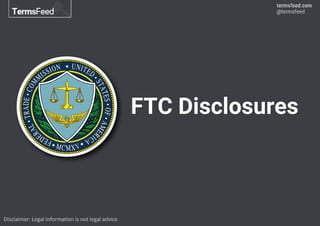FTC Disclosures
- 2. In the United States, the Federal Trade Commission (FTC) requires that you disclose to the public (1) if you participate in affiliate marketing or endorse something for compensation. (1) Link to https://www.ftc.gov/tips-advice/business-center/guidance/ftcs-endorsement-guides-what-people-are-asking#affiliate
- 3. Affiliate marketing is when a company pays compensation to a third party that generates traffic, leads or sales to the companyâs products. Compensation can be in the form of payment or other benefit including: Free products, samples or trials Special discounts or store credits Anything of value
- 4. Simply put, if you endorse something for any type of compensation, you need to disclose it according to the FTC.
- 5. This disclosure requirement aims to present consumers with as much information as possible when theyâre making decisions about purchases. If the compensation factor may change someoneâs opinion of the endorsement, he/she has a right to know.
- 6. Checklist for FTC Disclosures
- 7. 1 Do you need a disclosure? If you received any form of benefit from your endorsement, YES.
- 8. 2 When do you need to disclose? Every single time you post an endorsement where you receive a benefit. Each blog post, individual tweet, Instagram post, etc. must have its own disclosure within it.
- 9. 2
- 10. 3 What do you need to disclose? Let people know you receive some sort of compensation in exchange for your endorsement.
- 11. 3
- 12. 4 How do you need to disclose? Your disclosure needs to be: Noticeable, and Understandable
- 13. 4 Noticeable The FTC requires that disclosures be clear and conspicuous. They need to be placed close to your endorsement and be unavoidable by your users. Using logos, bright colors and fonts isnât necessary but can help your disclosure stand out. Noticeable
- 14. 4 Noticeable
- 15. 4 Noticeable The beginning of a blog post is good placement. Donât require a user to have to scroll to find your disclosure. A user could click on your links without having a chance to notice your disclosure.
- 16. 4
- 17. 4 Noticeable Platforms like Twitter and Instagram can have disclosures at the end since the posts are shorter and easy to see in one shot.
- 18. 4
- 19. 4 Understandable Write your disclosure in clear and easy-to-understand language.
- 20. Understandable 4
- 21. Examples of FTC Disclosures For blogs and websites For social media
- 22. Itâs common to see small icon-style disclosures at the top of blogs and websites that let users know that there are affiliate links in the post or on the page. These small disclosures then link to a full, more thorough disclosure page. Blogs and Websites
- 25. Having either just a small icon disclosure or a separate long disclosure by itself isnât adequate. The small disclosure isnât informative enough, and the long disclosure will be on a separate page, thus not noticeable enough. Use a combination of both. Blogs and Websites
- 26. Use hashtags to disclose on social media. A simple â#adâ hashtag or mention of the word âAdâ keeps your posts compliant. You can also include a disclosure statement. Social Media
- 27. Social Media
- 29. To properly disclose affiliate marketing and compensated endorsements, make sure your disclosure is: Clearly and conspicuously placed, Easily understood by your average consumer, and Included on every single endorsement post you make where you may earn compensation






























